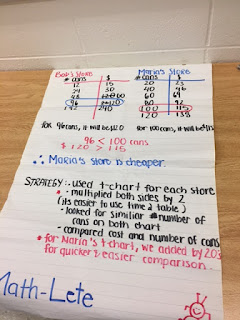This week in class we participated in a math congress.
Mathematical communication and discussion is essential for learning mathematics
because as we communicate we are able to reflect on, clarify, and expand our
ideas. The math congress was a great exercise that began with the teacher
assigning students to work in a group and work together on chat paper to create
a solution to the problem that the teacher assigns. The poster should have
ideas that are well thought and should present important strategies and
concepts that were used to solve their problems. While the students are working
away on their problems, it is a great time for the teacher to walk around the
class and assess how the students are doing. In our Math congress in class Pat
was walking around as we were working on our problems and she got a great idea
of how everyone was doing in regard to their understanding of the problem and
she was able to see the different mathematical strategies and the different
ideas that each of our groups were working towards. I can definitely see myself
using a math congress in my classroom because I think that it is extremely
important to have discussions in math and if students are not comfortable
discussing mathematics with the teacher during the lesson, this gives them the
opportunity to discuss ideas and concepts with their peers and gives them the
chance to collaborate critically.
As we finished up working on Joel’s Kitchen problem, we
posted our solutions around the class and has a gallery walk. This is a unique
strategy that has studnets move from station to station to view everyone else’s
work. the gallery walk allows students to get into discussion about the problem
in a mode of active engagement. It allowed us to see the many different
strategies and methods that others took, which helped us gain a deeper
understanding of Joel’s problem. I like this strategy a lot because it helps
the students understand that there is more than one way to solve mathematical
problems and this is beneficial because some individuals may not get how to do
a mathematical problem one way, but they understand how to do it another. The
gallery walk is also beneficial to teachers because it allows the teacher to
monitor the classroom and assess how the students are collaboratively working
to understand the mathematical concepts.
After the gallery walk, it is a good strategy to have
students return to their original groups to discuss things that they noticed
and to reflect on the overall process. Students can then decide if they would
like to add things to their original problem and think about whether or not
they would have approached the problem in the same way, with their newly
acquired information. This gives students opportunities to come to final
conclusion on what they saw and discussed and it also gives the teacher the
chance to assess the overall classroom’s understanding of the problem and
allows the teacher to provide feedback.


Hi Kevin,
ReplyDeleteI really liked how you mentioned the gallery walk. It really allows the students to peer assess, meaning they are able to see what other strategies their peers used to answer the same question. This lets the students find a possibly easier method or method they understand. I also like how this allows for us as teachers to understand the different ways our students think and learn.